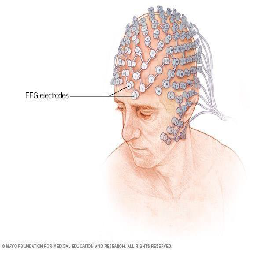Overview of the Electroencephalogram (EEG) signals
Keywords:
Diagnosing, ElectroencephalogramAbstract
In recent years the algorithms of machine learning were used for brain
signals identification as a useful technique for diagnosing diseases like
Alzheimer's and epilepsy. In this paper, the Electroencephalogram (EEG)
signals are classified using an optimized Quantum neural network (QNN) after
normalizing these signals. The wavelet transform (WT) and the independent
component analysis (ICA) were utilized for feature extraction. These
algorithms were used to reduce the dimensions of the data, which is an input to
the optimized QNN for the purpose of performing the classification process
after the feature extraction process. This research uses an optimized QNN, a
form of feedforward neural network (FFNN), to recognize the EEG signals.
The Particle swarm optimization (PSO) algorithm was used to optimize the
quantum neural network, which improved the training process of the system's
performance. The optimized QNN provided us with somewhat faster and more
realistic results. According to simulation results, the total classification for ICA
is 82.4 percent, while the total classification for WT is 78.43 percent; from
these results, using the ICA for feature extraction is better than using WT
Downloads
References
J. M. Kumar and V. K. Mittal, "EEG Data Acquisition System and Analysis of EEG Signals," 2021 2nd International Conference for Emerging Technology (INCET), 2021, pp. 1-5, doi: 10.1109/INCET51464.2021.9456431.
M. Saini, U. Satija and M. D. Upadhayay, "Wavelet Based Waveform Distortion Measures for Assessment of Denoised EEG Quality With Reference to Noise-Free EEG Signal," in IEEE Signal Processing Letters, vol. 27, pp. 1260-1264, 2020, doi: 10.1109/LSP.2020.3006417.
Wu, X. Y., S. H. Wang, and Y. D. Zhang. "Overview of k nearest neighbor algorithm theory and application." Computer Engineering and Application 53.21 (2017): 1-7..
Hafeez Ullah Amin, Wajid Mumtaz, Ahmad Rauf Subhani, " Classification of EEG Signals Based on Pattern Recognition Approach", 21 November 2017, Department of Electrical and Electronic Engineering, Universiti Teknologi Petronas, Seri Iskandar, Malaysia.
Dongmei Zhou and Xuemei Li," Epilepsy EEG Signal Classification Algorithm Based on Improved RBF", Chengdu University of Technology, Chengdu, , 23 June 2020, China.
Jianguo Liu, Blake Woodson," Deep Learning Classification for Epilepsy Detection Using a Single Channel Electroencephalography (EEG)", Proceedings of the 2019 3rd International Conference on Deep Learning TechnologiesJuly 2019.
Tahernezhad-Javazm, Farajollah, Vahid Azimirad, and Maryam Shoaran. "A review and experimental study on the application of classifiers and evolutionary algorithms in EEG-based brain–machine interface systems." Journal of neural engineering 15.2 (2018): 021007.
Lu, Yao, Huiping Jiang, and Wenqiang Liu. "A review of EEG signal classifier based on deep learning." Proceedings of Information Science and Cloud Computing—PoS (ISCC 2017), Guangzhou, China (2018).
Ömer Türk,Mehmet Siraç Özerdem,, “The convolutional neural network approach from electroencephalogram signals in emotional detection”, Volume33, Issue20 , 07 May 2021.
H. Donmez and N. Ozkurt, "Emotion Classification from EEG Signals in Convolutional Neural Networks," 2019 Innovations in Intelligent Systems and Applications Conference (ASYU), 2019, pp. 1-6, doi: 10.1109/ASYU48272.2019.8946364.
C. L. Zhen, Random Noise Suppression of Seismic Signal Based on Wavelet Transform, Donghua University of technology, 2018.
Chakole A.R., Barekar P.V., Ambulkar R.V., Kamble S.D. "(2019) Review of EEG Signal Classification". In: Satapathy S., Joshi A. (eds) Information and Communication Technology for Intelligent Systems. Smart Innovation, Systems and Technologies, vol 107. Springer, Singapore.
Pengcheng Ma, Qian Gao, "EEG Signal and Feature Interaction Modeling-Based Eye Behavior Prediction Research", Computational and Mathematical Methods in Medicine, vol. 2020, Article ID 2801015,
CCME 2 (7), 107-125 (2024) VISION PUBLISHER|125
pages, 2020.
R. Inoue, T. Sugi, Y. Matsuda, S. Goto, H. Nohira and R. Mase, "Recording and Characterization of EEGs by Using Wearable EEG Device," 2019 19th International Conference on Control, Automation and Systems (ICCAS), 2019, pp. 194-197, doi: 10.23919/ICCAS47443.2019.8971564.
B. Nguyen, D. Nguyen, W. Ma and D. Tran, "Investigating the possibility of applying EEG lossy compression to EEG-based user authentication," 2017 International Joint Conference on Neural Networks (IJCNN), 2017, pp. 79-85, doi: 10.1109/IJCNN.2017.7965839.
Fahimi, Fatemeh, et al. "Inter-subject transfer learning with an end-to-end deep convolutional neural network for EEG-based BCI." Journal of neural engineering 16.2 (2019): 026007.

Downloads
Published
How to Cite
Issue
Section
License

This work is licensed under a Creative Commons Attribution 4.0 International License.
Current Clinical and Medical Education













